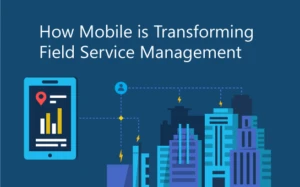
Four Major Technology Trends That Are Changing the Way Field Service Is Done
Field service is undergoing dramatic change. Customer expectations are rising. Mobile is transforming how customers and agents interact, and apps like Uber are setting the bar very high. That's just the beginning. The Internet of Things, algorithm-derived scheduling, real-time data, and broad integration will streamline operations, improve customer experience, and drive value for businesses.
Each of these solutions addresses ongoing problems facing field service operations. Companies that don’t deploy such solutions skillfully will be outpaced by their competition.
Here’s an example. What happens if, say, a part on an expensive piece of customer equipment begins to fail? If it’s not caught early on, the problem could become critical. Field agents scramble and try to fix the equipment before SLA penalties are triggered. If it’s under warranty, the work is not billed. The customer suffers unplanned downtime, and the supplier business incurs penalties and costs.
But when field service organizations bring these powerful solutions to bear, it’s a different story.
1. Mobile
Mobile has already begun having a major impact on how field service agents operate, on how dispatchers schedule, and on how customers expect to stay informed. (In fact, we wrote an entire blog post about it here.) The power of ubiquitous mobile devices to shape the way field service operations function will continue to be felt as a value multiplier for each of the other four transformative solutions. After all, mobile devices are powerful computers and, when combined with the solutions below, they equip field agents with powerful capabilities.
2. Internet of Things (IoT)
The power of IoT is the ability of machines to talk to each other — with or without human involvement. This means that equipment can constantly send signals to servers about status and performance. So when that part begins to perform out of spec, the information is sent upstream and analyzed.
3. Real-Time Data Analytics
With real-time data analytics, powerful algorithms go to work and keep an eye on everything from travel time to job profitability to equipment performance. When a part begins to fail, the algorithm can tell. The result? The part is automatically flagged for attention. Either a dispatcher gets a message and routes a field agent to make a repair, or the field service management solution simply schedules the repair itself.
4. End-to-End Integration
The reason it all works so smoothly is integration. When your field service solution is plugged into equipment in the field through IoT, to field agents through mobile apps, to powerful analytical tools that handle shifting demand by automatically assigning workloads, and to management views and dashboards such that they have granular visibility of entire operations, you have an unprecedented level of clarity. This clarity allows for insights that drive new opportunities and new successes.
Don’t let your competition take advantage of these capabilities before you do. Bring an end-to-end integrated field service management solution to your organization.
Learn more
Questions on Microsoft Dynamics Business Solutions? Call 1-888-477-7989

